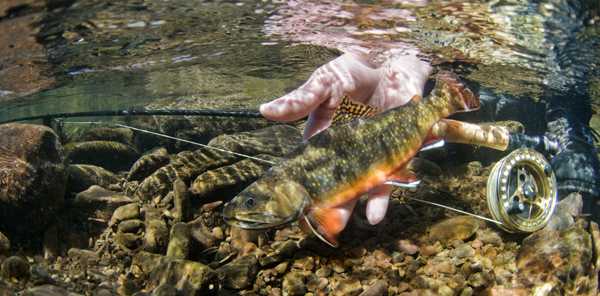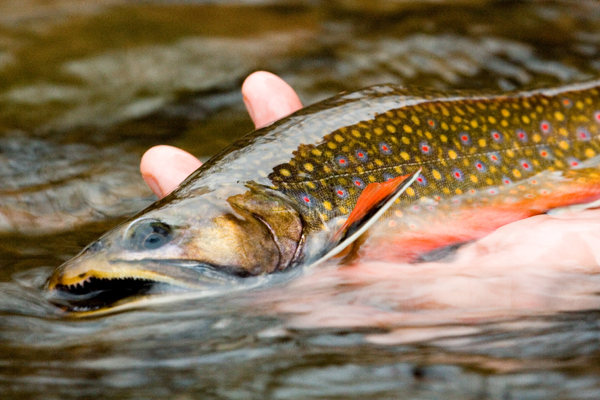The story of brook trout fishing in Maryland is one steeped with tradition and lore. From Meshach Browning's explorations of western Maryland to Lefty Kreh's more modern pursuits, celebrated anglers have been tempting these wily fish with rod and reel for generations and although these fish may be lacking in stature relative other gamefish, none can compare to their physical beauty. Vermiculations of gold and olive green, fading into flanks of bright orange to blood red often leave even the most prosaic angler awestruck.
 Brook trout are members of the salmonid family, which includes other fishes such as brown and rainbow trout and various species of salmon. However, brook trout are not actually a trout, but rather a charr. They typically inhabit only the most pristine bodies of water and thus, can be wonderful predictors of water quality and stream health.
Brook trout are members of the salmonid family, which includes other fishes such as brown and rainbow trout and various species of salmon. However, brook trout are not actually a trout, but rather a charr. They typically inhabit only the most pristine bodies of water and thus, can be wonderful predictors of water quality and stream health.
In Maryland brook trout can be found from the Piedmont to the far western end of the state in Garrett County. Areas with high brook trout densities include the Gunpowder River watershed, the Catoctin Mountains between Hagerstown and Frederick, and on the Appalachian Plateau, west of Cumberland. More specifically, Garrett County is home to the highest density of brook trout streams, as well as the stronghold for brook trout in Maryland - the upper Savage River system. Anglers hoping to wet a line in pursuit of the cagey brook trout would be best served focusing in one of these areas.
Fishing for brook trout can be as simple as a worm and a hook on the old Zebco, or as complicated as a dry-dropper rig fished on an 8' Orvis fly rod. That is part of the beauty of brook trout; they don't typically discriminate among presentations! However, as eager as they can be to bite, if you don't pay attention to some simple details, hooking these fish can seem nearly impossible! Here are a few simple tips to get you started on right path to catching these little gems;
- Dress in drab clothing. These fish are typically eager to bite unless they feel threatened. Wearing drab clothing or camouflage will help to conceal you while making your casts.
- Fish in an upstream direction. Fish are built to face upstream and into current. By fishing upstream, you can sneak up behind them, allowing you to get closer to them and make a more accurate cast.
- Keep moving. Wild fish will usually take a good presentation quickly. If you make more than a few casts with no luck in a spot, move on to new water!
- Practice with your gear! Brook trout typically live in smaller streams with plenty of cover. You need to be able to accurately place your presentation from a distance in order to get these fish to bite. If you aren't familiar with your gear, making an accurate cast will be difficult.
 Once you know where to go, how to dress, and can make an accurate cast with your gear, it is time to choose your lure! For bait anglers, a #8 or #10 baitholder hook on 4 lb. test monofilament is a great setup. Tip that with a garden worm and you are well on your way! For folks who like to throw artificial lures on spinning tackle, inline spinners such as a Mepps, Rooster Tails, or Panther Martins are hard to beat, but small spoons or crankbaits will catch fish as well. Finally, for the fly anglers, a brook trout box is very simple. An assortment of black wooly buggers (#8-#12), some elk/deer hair caddis(#14-#16), and a few beadhead pheasant tail nymphs (#14-#18) will catch brook trout from Maine to Georgia!
Once you know where to go, how to dress, and can make an accurate cast with your gear, it is time to choose your lure! For bait anglers, a #8 or #10 baitholder hook on 4 lb. test monofilament is a great setup. Tip that with a garden worm and you are well on your way! For folks who like to throw artificial lures on spinning tackle, inline spinners such as a Mepps, Rooster Tails, or Panther Martins are hard to beat, but small spoons or crankbaits will catch fish as well. Finally, for the fly anglers, a brook trout box is very simple. An assortment of black wooly buggers (#8-#12), some elk/deer hair caddis(#14-#16), and a few beadhead pheasant tail nymphs (#14-#18) will catch brook trout from Maine to Georgia!
We encourage you to get out there and challenge your angling skills on our only native salmonid! Just remember that these fish are as fragile as they are beautiful, so please use barbless hooks and handle the fish as little as possible if you intend to release them!
Check out the following links to help plan your next brook trout fishing adventure in Maryland;